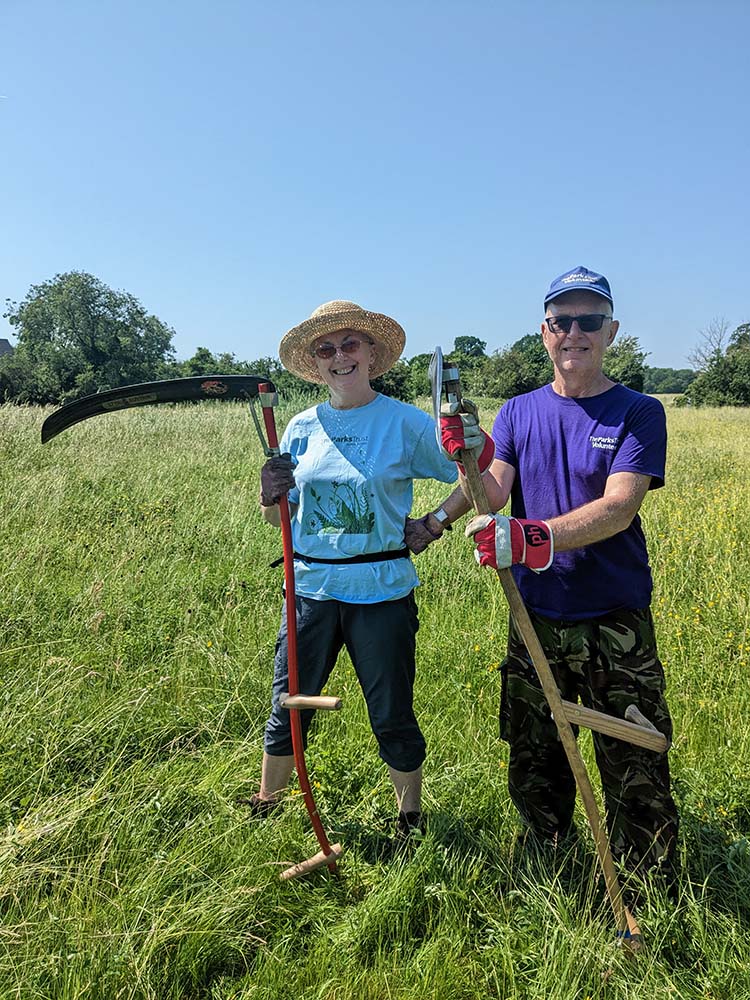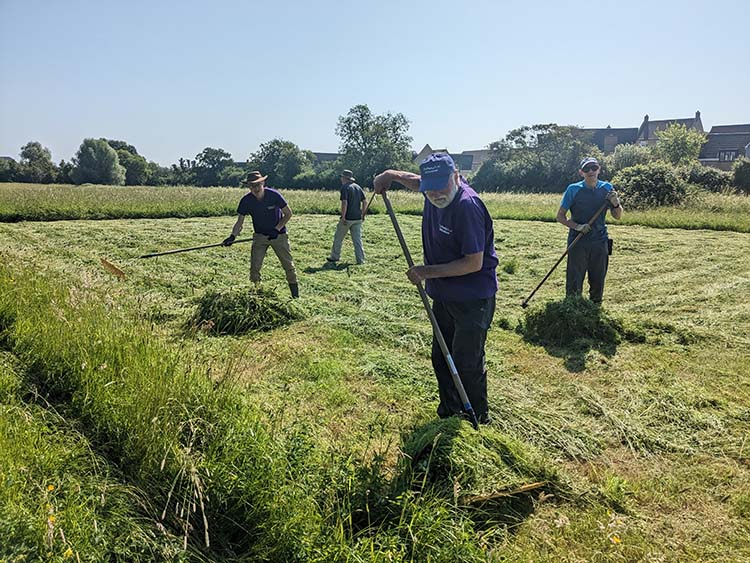Carla Boswell, Biodiversity Officer, Milton Keynes Park Trust
Since 2020 The Parks Trust has taken over the management of Oxley Mead SSSI – a 3.7 ha magnificent floodplain meadow (MG4) in Milton Keynes. This nationally rare grassland is the only area of old floodplain meadow of its kind in Milton Keynes, so quite special and unique, providing us with a great opportunity to learn how to best manage this site for its SSSI status.
The Floodplain Meadow Partnership (FMP) have monitored this site for many years to assess impacts from surrounding development on the meadow vegetation. Using these baseline data, the FMP designed a trial to measure the effect of three different hay-cutting dates on meadow vegetation. We at The Parks Trust have taken on the challenge of managing this hay cutting trial on a series of 20 x 25 m plots located in four blocks across Oxley Mead. We also organise aftermath grazing, using low density cattle (5) to remove any further nutrient build up in the floodplain meadow.
The Parks Trust has a great resource of local volunteers wanting to help out with various activities across the organisation, contributing to 11,000+ hours in 2023 alone. With around 250 volunteers, they play a vital role in helping The Trust to keep the parks beautiful and exciting places to visit. With our Conservation Tasks, these are the most physical of activities in keeping the traditional countryside land and habitat management techniques alive for our nature reserves and some parkland. From coppicing to hedge laying, volunteers love to be active and learn new skills to improve biodiversity, delivering them with other organisations within the city.
The first cut of the trial is planned for mid-June each year, and is undertaken by volunteers using scythes. Only small blocks are required to be cut, so volunteer scythers are a perfect solution.
Using a scythe
Why choose a traditional hand scythe? Many reasons, yes it might be slow but that’s better for the wildlife and improving grassland species diversity. Scythes are historically what first gave rise to flower rich meadows, and potentially offer the key to understanding and managing these special grassland habitats.
The main advantage of using a scythe is that you have more control over the time of grassland cutting, in terms of being slower and more selective within a meadow itself. In terms of habitat and wildlife benefits, this results in varying grass lengths to create a mosaic of micro-habitat stages for small mammals, birds and insects. Additionally, a scythe is more accessible for certain sites such as a hillside and/or where heavy machinery would destroy the habitat and cut too short in one day.
Using a scythe will teach you the importance of mowing meadows at the right time - as we soon discovered in areas which have been neglected or left too long (before The Trust’s ownership). This neglect compromises flowering plant diversity, but also makes mowing difficult.
All wildflower meadows provide a huge food resource for pollinators, providing nectar and pollen that they rely on. Sadly, these habitats are becoming increasingly rare due to changes in farming practices and land use.
Since taking on Oxley Mead, The Trust has invested in more Austrian Scythes and a pedestrian mower, doubling our efforts to tackle this large meadow by sensitive management. A couple of volunteers have also invested in their own scythes, so occasionally we have up to 6 scythes in one session!
Mid-June is usually a lovely sunny day, one of the first hot days of the year, so it’s thirsty work and there is little shade for the army of volunteers. We work with the support of in-house Park Trust teams and 2 tractors and trailers, to swap loading one at a time and with transportation of the arisings from the meadow site. Sometimes we are busy waiting for the tractor to return to load up the piles of hay, as the composting site is the other end of the city. These breaks give us plenty of time to rescue the immature toadlets and field voles hiding in the piles, spotting butterflies and stumbling over bumblebee nests. Muntjac and Roe Deer are regularly seen in the meadow before we descend upon it; and I also like to test our volunteer’s grassland species knowledge.
The first cut is organised for mid- June. The Parks Trust Volunteers originally wanted to scythe all 4 plots. This was a feat not to be undertaken by hand and we quickly learned that with only 4 Austrian scythes, rotating 12 volunteers we could realistically only cut 1 plot in 4 hours with plenty of breaks and then rake up all 4 plots to remove from site.
The volunteers are now well practiced in using the scythes, with a reminder at each session going over the basics in Health and Safety. The most important thing is maintaining a minimum scythes length distance from other volunteers, and wear gloves to sharpen and tightening the bolts before we start. Scything is also a sensory engagement with the grass itself and you learn more about the structure and character of the fine grasses and herbs. From the nice bit of fine grass to scythe to the tough tussocky areas, the volunteers soon learn to notice the species difference and diversity through hand scything it. Oxley is the most enjoyable meadow to scythe by far across some of the sites we manage by hand.
In the early cut, one plot is scythed by volunteers and three other plots are mechanically cut by a pedestrian mower. Whether this will result in a difference in species diversity is yet to be analysed. With the mechanical cut you get a shorter grass length compared to hand scythes which cuts at a higher length, and therefore doesn’t remove as much of the arisings. All four early plot arisings are raked off by volunteers and staff. This is repeated for the Late plots at the beginning of September. The mid cut is carried out in Mid-July by the tractor and bailer, making haylage as winter feed for our cattle. Sadly no volunteers are necessary for this part of the process.
Finally there’s one late cut scheduled for September with the pedestrian mower and the volunteer army to rake up the arisings into the tractor trailers again. There’s much comparison over the seasons cuts, where volunteers have gained a better feel and understanding of the plant community growing here through using a scythe and raking.
By managing Oxley Mead, the staff and volunteers have gained a valuable insight into how the species diversity changes with the different timings of the cut, with the early cut being more beneficial for species diversity. In June before we start cutting, everyone can all see the different plots by the changes in plant species across the site, with each plot distinctively visible. The first year it was difficult to visualise the process and project but by year four, the volunteers are very much invested and are learning species and vegetation classification. More importantly they keep returning each year to repeat the Early cut, perhaps it maybe the cake?

